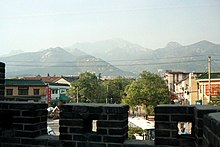
A castle is a type of fortified structure built during the Middle Ages predominantly by the nobility or royalty and by military orders. Scholars usually consider a castle to be the private fortified residence of a lord or noble. This is distinct from a mansion, palace, and villa, whose main purpose was exclusively for pleasance and are not primarily fortresses but may be fortified. Use of the term has varied over time and, sometimes, has also been applied to structures such as hill forts and 19th- and 20th-century homes built to resemble castles. Over the Middle Ages, when genuine castles were built, they took on a great many forms with many different features, although some, such as curtain walls, arrowslits, and portcullises, were commonplace.

A merlon is the solid upright section of a battlement in medieval architecture or fortifications. Merlons are sometimes pierced by narrow, vertical embrasures or slits designed for observation and fire. The space between two merlons is called a crenel, and a succession of merlons and crenels is a crenellation. Crenels designed in later eras for use by cannons were also called embrasures.

A battlement, in defensive architecture, such as that of city walls or castles, comprises a parapet, in which gaps or indentations, which are often rectangular, occur at intervals to allow for the launch of arrows or other projectiles from within the defences. These gaps are termed embrasures, also called crenels or crenelles, and a wall or building with them is described as crenellated; alternative older terms are castellated and embattled. The act of adding crenels to a previously unbroken parapet is termed crenellation.

Barbettes are several types of gun emplacement in terrestrial fortifications or on naval ships.
Roman siege engines were, for the most part, adapted from Hellenistic siege technology. Relatively small efforts were made to develop the technology; however, the Romans brought an unrelentingly aggressive style to siege warfare that brought them repeated success. Up to the first century BC, the Romans utilized siege weapons only as required and relied for the most part on ladders, towers and rams to assault a fortified town. Ballistae were also employed, but held no permanent place within a legion's roster, until later in the republic, and were used sparingly. Julius Caesar took great interest in the integration of advanced siege engines, organizing their use for optimal battlefield efficiency.

The MAC mle 1931 machine gun, was a machine gun used in French tanks of the World War II era, as well as in fortifications such as the Maginot line. It is also sometimes known as the JM Reibel, from Jumelage de mitrailleuses, or Reibel twin-mounted guns and really refers to the specialized twin-mounting frame used in JM cloche cupolas on the Maginot Line fortifications, while MAC mle 1931 refers specifically to the gun. The JM twin-mounts were the standard emplacement for the mle 1931 in fixed fortifications, while tanks and other AFVs received single guns.

British hardened field defences of World War II were small fortified structures constructed as a part of British anti-invasion preparations. They were popularly known as pillboxes, a reference to their shape.

The existence of the earliest forts in India have been substantiated by documentation and excavation. In the medieval times, the architecture of the forts had both Hindu and Muslim influence. The forts constructed by the British initially opted for simple designs. The existing castles are continually modified and many of them are privately owned.

The GFM cloche was one of the most common defensive armaments on the Maginot Line. A cloche (bell) was a fixed and non-retractable firing position made of a thick iron casting which shielded its occupant. By comparison, turrets could be rotated and sometimes lowered so that only the top shell was exposed.

The fortifications of Xi'an, also known as Xi'an City Wall, in Xi'an, represent one of the oldest, largest and best preserved Chinese city walls. It was built under the rule of the Hongwu Emperor Zhu Yuanzhang as a military defense system. It exhibits the "complete features of the rampart architecture of feudal society". It has been refurbished many times since it was built in the 14th century, thrice at intervals of about 200 years in the later half of the 1500s and 1700s, and in recent years in 1983. The wall encloses an area of about 14 square kilometres (5.4 sq mi).

The Château de Kaysersberg is a ruined castle in the commune of Kaysersberg in the Haut-Rhin département of France.

An arrowslit is a narrow vertical aperture in a fortification through which an archer can launch arrows or a crossbowman can launch bolts.

A curtain wall is a defensive wall between fortified towers or bastions of a castle, fortress, or town.
A weapon mount is an assembly or mechanism used to hold a weapon onto a platform in order for it to function at maximum capacity. Weapon mounts can be broken down into two categories: static mounts and non-static mounts.

The siege of Château Gaillard was a part of Philip II's campaign to conquer John, King of England's continental territories. The French king besieged Château Gaillard, a Norman fortress, for six months. The Anglo-Normans were beaten in the battle and the consequence was the fall of Normandy.

Dally Castle is a ruined 13th-century stone motte-and-bailey fortress in Northumberland, and one of the first hall houses in Northumberland. It lies 5 miles (8.0 km) west of Bellingham Castle, and 4 miles (6.4 km) west of Bellingham on the Chirdon Burn, a tributary of the North Tyne. Dally Castle House was built in the 18th century next to the castle. Across the road lies a small flour mill used to grind wheat during the Napoleonic War.

Sechsschartenturm, heavy MG bunker, La Mare Mill, or 4-S WaKoFest, Wn La Mare Mill, consists of a sechsschartenturm and a personnel bunker. The Organisation Todt built it to an Atlantic Wall standard on a commanding position near the demolished La Mare Mill during the Occupation of Jersey.

In fortification architecture, a rampart is a length of embankment or wall forming part of the defensive boundary of a castle, hillfort, settlement or other fortified site. It is usually broad-topped and made of excavated earth and/or masonry.
A loophole is a protected small opening, which allows a firearm to be aimed and discharged, while providing cover and concealment for the rifleman. To prevent detection, the rifle's muzzle should not protrude through the loophole, particularly at night to hide the muzzle flash.

In architecture, a splayed opening is a wall opening that is narrower on one side of the wall and wider on another. When used for a splayed window, it allows more light to enter the room. In fortifications, a splayed opening is used to broaden the arc of fire.























